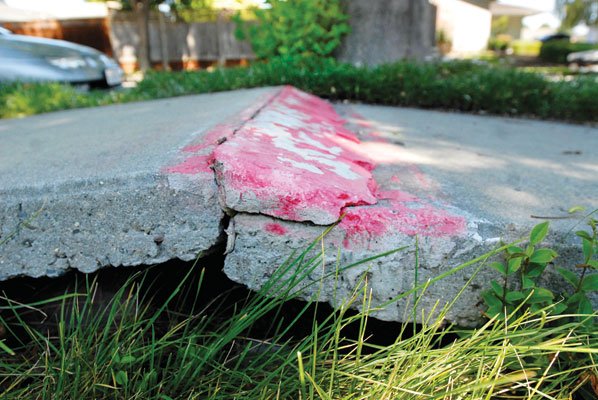UPDATE:
At the request of City Councilman Bob Dillon, the body will
discuss repairing sidewalks damaged by city trees and covering the
entire bill at its Sept. 29 study session. The body is expected to
actually vote on the matter at its next regular meeting scheduled
for Aug. 6.
It’s go time for sidewalks.
At the request of City Councilman Bob Dillon, the body will discuss repairing sidewalks damaged by city trees and covering the entire bill at its Sept. 29 study session. The body is expected to actually vote on the matter at its next regular meeting scheduled for Aug. 6.
Last week staff told the council the concrete problem will cost anywhere from $7.3 million to $11.7 million to fix and that the city cannot afford to do so after buying Gilroy Gardens in January. But Dillon said he will recommend taking $3.7 million from the city’s shrinking reserve fund, a move that would drop Gilroy’s rainy day balance to about $13 million, down from more than $26 million a year ago.
“Through good times and bad, staff has told us that we’ve never been able to afford it, but the real reason is we haven’t had political will to afford it,” Dillon said.
Councilman Craig Gartman agreed: “It’s time to put the oars in the water and get this boat moving.”
Last week the body voted to hold a study session on the issue Sept. 29, but because no action can be taken during a study session, Dillon will broach his idea then and move to have a vote at the next regular meeting Aug. 6, according to City Clerk Shawna Freels.
The latest sidewalk survey identified 2,555 properties with damaged walkways, and trees cracked nearly all of them, but making sure the city only fixes those broken by city trees between the sidewalk and curb – and not by someone’s private tree with expansive front-yard roots – will require another estimate, according to City Engineer Rick Smelser.
“I couldn’t tell you how much that would cost today, but we have the information,” Smelser said.
The revised projection will surely be at least $3.7 million, though, Dillon said, so the city might as well get started.
Whether there will be a ‘No’ or ‘Yes’ next to Councilwoman Cat Tucker’s name remains to be seen. The freshman council member has been the swing vote on many issues and vowed to fix sidewalks during her campaign last year, but “I really have to think about this,” she said Monday.
“The numbers aren’t even that clear, and I am a cautious person, not one to spend from the savings account unless we absolutely need it,” Tucker said.
Mayor Al Pinheiro will be out of town Sept. 29, but Freels said he will attend via telephone so he can cast a vote. Neither Pinheiro nor City Administrator Tom Haglund returned messages by 3 p.m. Monday.
Along with Pinheiro and Councilman Peter Arellano, Councilman Dion Bracco has advocated splitting repair costs with residents. After reading Dillon’s e-mail to Freels asking her to place the item on the upcoming agenda, Bracco warned against “throwing money at the problem without a plan” for a new street tree policy or one to address long-term sidewalk repair.
“I believe this is totally irresponsible to throw money at a problem without any plan in the future. What about the trees?” Bracco said, adding that the city’s “sky-rocketing gang problem” and other infrastructure deserve money, too. Plus, he said, if the council uses reserves now and makes more cuts to help narrow the city’s nearly $4 million deficit, residents may experience decreased services, or the city may not be able to hire more police officers, rendering sidewalks not such a big issue anymore.
“We need to put this on the ballot. If the citizens say, ‘Let’s fix the sidewalks,’ then we fix them,” Bracco said.
Everyone on the council has acknowledged the sidewalk dilemma is an election issue, but Councilman Perry Woodward said he plans to live up to his campaign promise to fix all the sidewalks.
“Councilmen Dion Bracco and Peter Arellano both said they’d fix the problem when they ran (in 2005), and now they’re like sea anchors on the whole process,” Woodward said. “If the city would’ve been doing what it should’ve been doing all along – fixing the sidewalks – then we wouldn’t be in this position, and we wouldn’t have this extra money in the reserve.”
But residents who have fixed their sidewalks and split the cost with the city in some way have argued that giving their neighbors a free ride seems unfair. This includes Bracco.
“I fixed my sidewalks, and I don’t think my money should go to fix people’s who don’t care about theirs,” Bracco said. Councilwoman Cat Tucker has heard similar thoughts from constituents.
If left unaddressed, City Hall will spend the $41,580 it has left to repair sidewalks by month’s end. That’s because dozens of property owners have taken advantage of the city’s nascent 80-20 program, whereby residents evenly split the cost of sidewalk repair with the city and then pay nothing for new curb and gutters, asphalt and tree removal, so they end up footing about 20 percent of the total cost.
Last week, Gartman and Woodward voted against a motion to hold a study session if it meant continuing the 80-20 plan, which is why Bracco described Dillon’s reserve fund proposition as “surprising” seeing as “he voted to continue the 80-20 plan last week. Shortly after that vote last week, though, the body split 4-3 – with Arellano, Bracco and Pinheiro voting ‘no’ – to hold a study session Sept. 29 to essentially “dig deeper,” as Woodward put it.
So far 67 residents have participated in the 80-20 program. Some hired their own contractors and then billed the city for its 80-percent portion while others had the city do all the work and then sent in a check for about 20 percent. When the city does the legwork, it adds overhead costs for sending the project out to bid, clearing out the physical area, setting up traffic controls and inspecting the work, Smelser said.
By the numbers
– $11.7 million: Total cost to repair sidewalk areas* if city does all the work
– $7.4 million: Total cost if residents hire contractors and then bill city
*”Sidewalk area” includes removing and replacing sidewalk, grinding, tree replacement with root barriers, ADA ramps for corner properties, curb and gutter replacement and driveway and parkstrip improvements.















